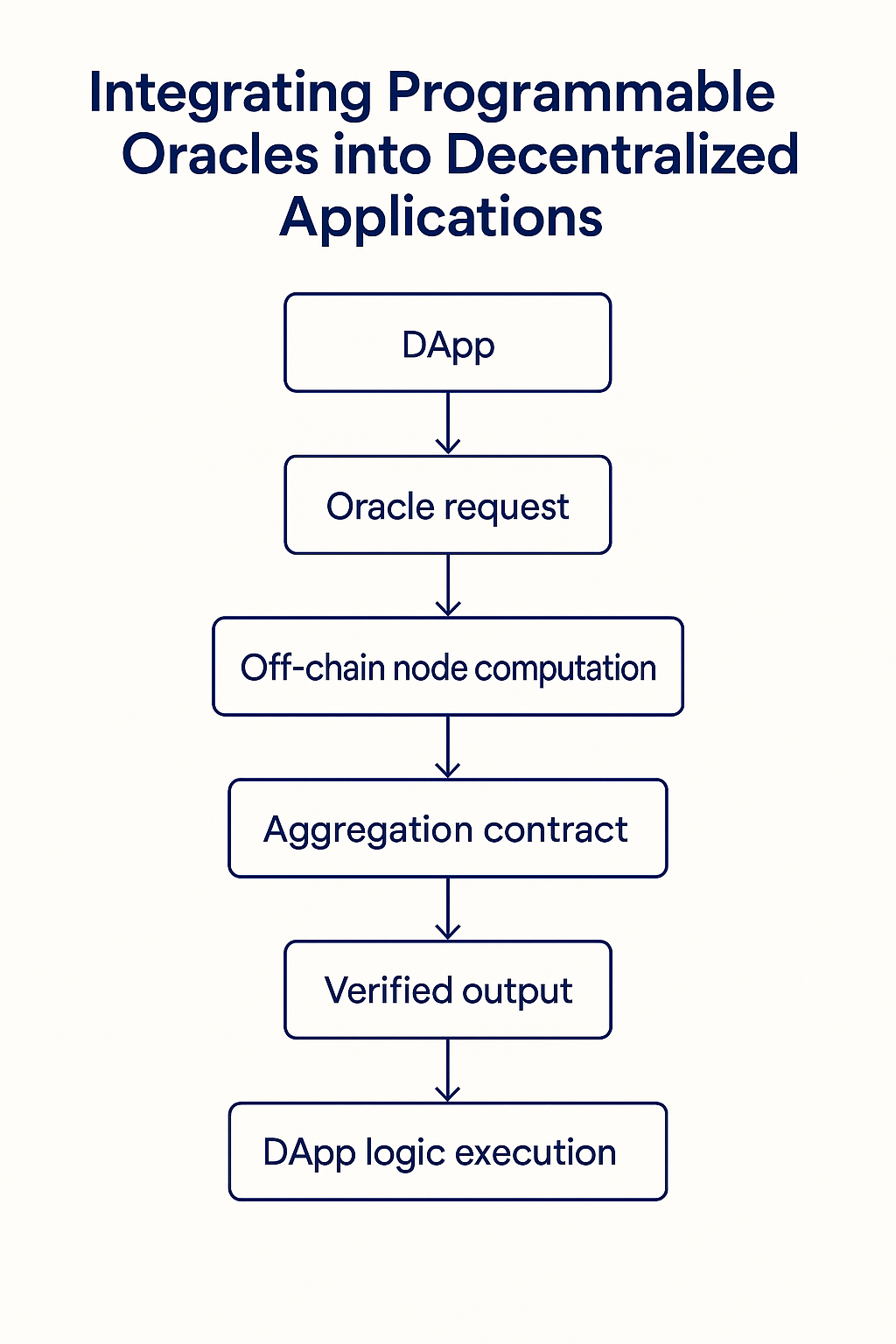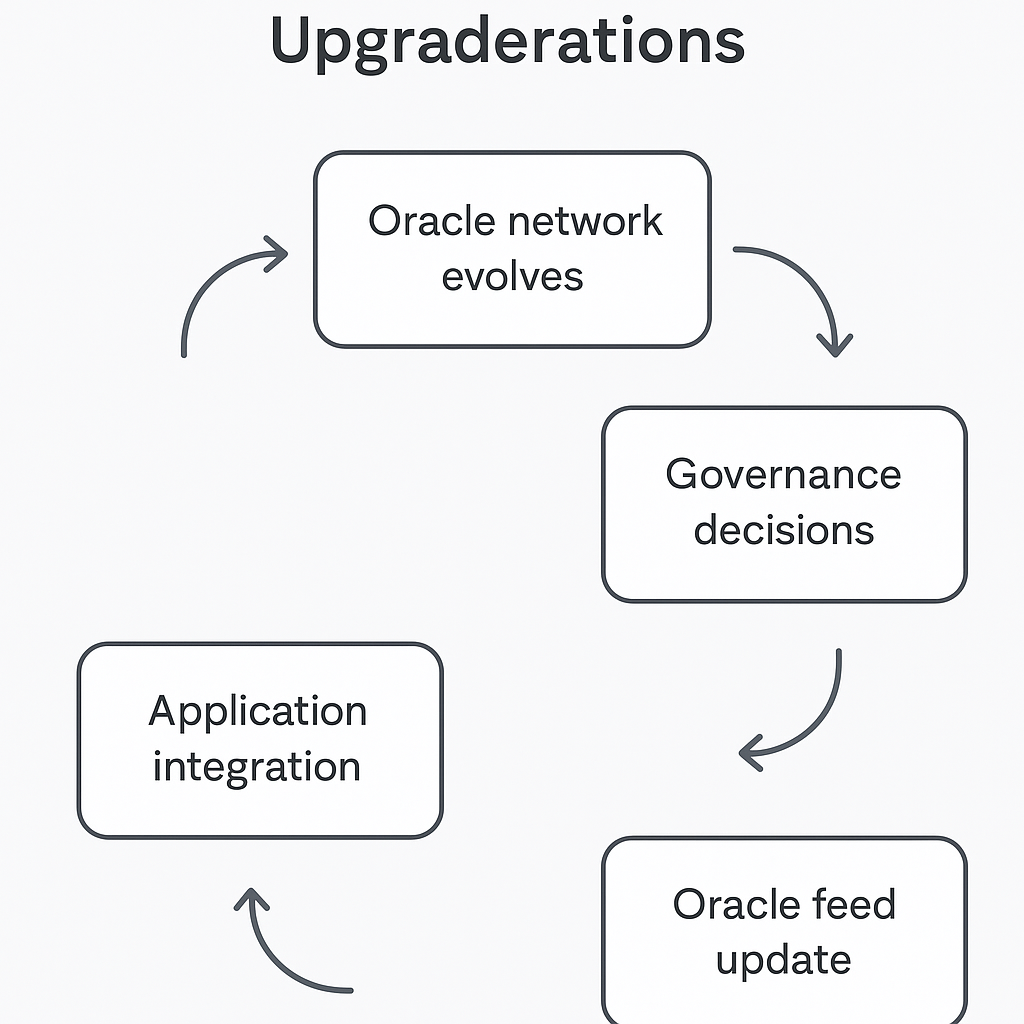Building With Programmable Oracles
This module focuses on the developer’s perspective. It explains how decentralized applications interact with oracle networks, the tooling available for integration, and best practices for security, reliability, and cost management. Learners also explore governance and upgrade considerations, real-world workflows, and the outlook for building applications that combine blockchain logic with verifiable off-chain computation.
Integrating programmable oracles into decentralized applications

From a developer’s perspective, programmable oracles are not external accessories but extensions of smart contract logic. Building with them requires understanding both the on-chain and off-chain components that make up the oracle workflow. The on-chain side involves interacting with oracle contracts that expose functions for requesting and receiving data.
These contracts enforce rules of verification and aggregation, ensuring that results delivered to applications reflect decentralized consensus rather than the report of a single source. The off-chain side involves the oracle network itself, where nodes fetch data, perform computation, and transmit signed outputs. Developers design applications to submit requests and consume oracle responses in ways that are predictable, verifiable, and aligned with the economic logic of their use case.
Tooling and developer environments
To make integration more accessible, most oracle networks provide software development kits, templates, and documentation that abstract away low-level details. These tools allow developers to write contracts that issue queries to oracles, subscribe to data feeds, or trigger off-chain computation through standardized interfaces.
In practice, this means developers can focus on designing the logic of their application without needing to manage the complexity of sourcing, validating, and processing external data. Test networks and sandbox environments are also essential, providing controlled settings where applications can simulate oracle interactions before going live. This reduces the risk of unforeseen issues when contracts begin interacting with real-world data on mainnet deployments.
Security and reliability best practices
Building with programmable oracles requires careful attention to security. Smart contracts that depend on external data should always account for the possibility of delays, anomalies, or failures in oracle delivery. Developers often include fallback mechanisms, such as halting execution if data deviates significantly from expected ranges or if no update is received within a set timeframe.
Contracts should be designed to minimize the impact of incorrect data, either by limiting exposure per transaction or by requiring multiple confirmations before critical state changes occur. In addition, relying on decentralized oracle networks rather than single providers is a basic principle for trust minimization. Security audits of both the smart contract and the oracle integration are indispensable before deployment.
Economic design and cost awareness
Oracles are not free services, and their integration introduces recurring costs for applications. Each data request or update consumes gas, and node operators must be compensated for their work in fetching and verifying information. Developers need to consider how often data must be updated to meet the functional requirements of their application without incurring unsustainable costs.
For instance, a lending protocol may require price feeds to be refreshed frequently, while an insurance product might only need verification when a claim condition arises. Balancing freshness, reliability, and cost is central to sustainable design. Applications that underestimate oracle costs may find themselves unable to scale, while those that over-provision risk wasting resources unnecessarily.
Practical examples of oracle-powered workflows
In practice, building with programmable oracles involves designing workflows that combine off-chain events with on-chain execution. A derivatives contract, for example, might require continuous updates of volatility indices and interest rates, with settlement logic triggered when expiry conditions are met. A decentralized insurance contract might need multiple weather data sources, with the oracle program computing average rainfall and applying exclusion criteria before reporting the outcome.
In cross-chain contexts, an oracle may deliver proofs of finality from one blockchain to another, enabling asset transfers or liquidity routing. These examples show that developers are not merely consuming data but embedding external computation directly into the logic of their applications.
Governance and upgrade considerations

Oracle integrations cannot be static, since data sources, computation methods, and governance structures evolve over time. Developers must design contracts with upgradeability in mind, either through modular architectures or governance-controlled proxies that allow oracle feeds to be updated. This ensures that applications remain functional even as the underlying oracle network changes its technical standards or business arrangements.
At the same time, upgradeability introduces its own governance risks, since control over oracle selection or replacement can become a target for exploitation. Designing transparent and decentralized processes for upgrades is therefore essential, particularly for protocols handling significant user funds.
The future outlook for builders
Looking ahead, building with programmable oracles will likely become more seamless as tooling matures and standards consolidate. Just as web developers rely on APIs to integrate third-party services, blockchain developers may come to rely on oracle networks as standard utilities for computation and data delivery. The rise of tokenized real-world assets, cross-chain liquidity, and decentralized autonomous organizations will all depend on reliable oracle infrastructure.
In addition, the convergence of artificial intelligence with oracle computation may allow for more sophisticated decision-making processes, where models trained on external data can influence on-chain outcomes in transparent and verifiable ways. For developers, this means that oracles will not only remain relevant but become integral to the design of complex, autonomous applications that extend beyond the limitations of purely on-chain logic.
Building the bridge between worlds
The role of programmable oracles is ultimately to connect blockchains to the external environment without undermining the principles of decentralization. For developers, this means learning to design applications that treat oracles as secure, programmable intermediaries capable of computation as well as data delivery.
Building with them involves technical integration, economic planning, and governance foresight. As standards emerge and adoption accelerates, developers who master oracle integration will be positioned at the frontier of blockchain innovation, where decentralized systems interact with markets, institutions, and real-world processes in ways that are both automated and trustworthy.





